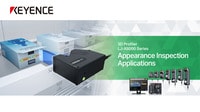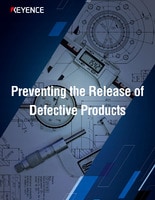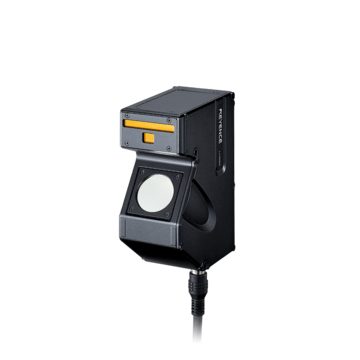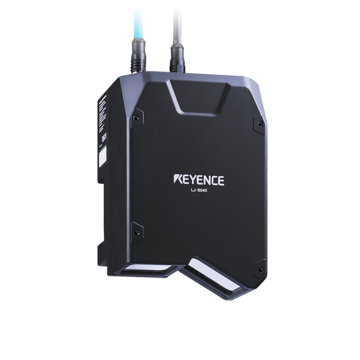Measurement Sensors
Dimension Measurement
Displacement Measurement
Defect Detection Sensors

Defect and damage detection remains a crucial aspect of modern manufacturing. Identifying problems helps ensure high quality products and prevents financial/reputational damages to the brand.
However, defect and damage detection aren't without their challenges. A good solution must be fast enough to keep up with production and robust enough to work on thousands of different products of varying sizes, types, and designs. This is particularly true when inspecting bulk packages (such as products placed inside boxes for transport).
Furthermore, damage can sometimes affect date and lot coding, which makes traceability nearly impossible. Fortunately, KEYENCE has the solution—defect and damage detection sensors.
What Is a Defect Detection Sensor?
Defect sensors identify flaws in manufactured products as they move through the production line. These flaws may be physical (like dents, scratches, or deformations) or structural, such as missing elements or compromised surfaces.
Unlike manual, human-led inspections, defect detection systems operate automatically in real time and are designed to work without contact, preserving material integrity while providing fast, reliable feedback.
Key Features of an Advanced Defect Detection Sensor
Advanced defect sensors are built for speed, accuracy, and adaptability. They use laser triangulation, structured light, or shadow-based detection to measure shape, surface, and depth variations. Many models offer sub-millimeter resolution and high-frequency sampling to catch even the slightest deviations. These sensors operate reliably under harsh factory conditions and require minimal recalibration. Their compact builds allow easy integration into tight setups, while real-time data feedback supports fast-paced lines and detailed quality analysis.
How Assisted Defect Recognition Improves Quality Control
Assisted defect recognition takes inspection further; instead of just flagging deviations, the system uses image processing or pre-configured models to interpret what it sees, allowing it to detect and classify defects. This results in a more consistent output with fewer false calls and reduces the reliance on operator judgment.
Over time, the system learns from repeat issues and refines detection boundaries, so whether the system is tracking surface flaws or identifying damage detection in manufacturing environments, assisted recognition adds depth to visual inspections.
We’re here to provide you with more details.
Reach out today!

Applications of Damage Detection Sensors in Industrial Settings
Defect detection sensors support damage detection in manufacturing across a wide range of industries, including:
Automotive
Sensors identify dents, weld flaws, and surface irregularities on body panels or structural parts.
Electronics
Sensors detect scratches, warping, or other micro-defects that can affect circuitry.
Food production
Sensors verify shape, volume, and packaging consistency during high-speed processing.
Pharmaceuticals
Sensors prevent packaging errors and maintain product uniformity on regulated lines.
Across all sectors, early detection prevents costly errors and production downtime.
Choosing the Right Defect Detection Sensor for Your Industry
When selecting a defect sensor, the inspection challenge should lead the decision. Laser profilers offer precise shape mapping and high-speed scanning if you need to measure subtle surface deformations, like dents or waviness in panels.
Optical micrometers provide reliable measurements using shadow-based detection for tasks involving edge stability or dimensional consistency.
Structured light or confocal sensors can deliver accurate, contact-free readings in environments with reflective surfaces or complex contours.
The right solution depends on material properties, inspection speed, and process integration needs.
Why KEYENCE’s Defect and Damage Detection Sensors Stand Out
KEYENCE sensors are built for in-line, real-time inspections in active industrial environments and are designed to detect dents, measure surface profiles, and support scratch detection in manufacturing while delivering fast and repeatable results.
From assisted defect recognition to high-speed measurement, KEYENCE brings confidence with our range of laser 1D and laser 2D solutions. Let us help you find the sensor you need. Contact us today!
Contact us to learn more about how our advanced technology can help take your business to the next level.
Contact Us
Related Products
Applications
Dimension Measurement
- Thickness and Width Measurement
- Step Height Measurement
- Inner and Outer Diameter Measurement
- Measuring Angles
- Meandering/Edge Measurement
Displacement Measurement
- Positioning and Stroke Length Measurement
- Vibration and Runout Measurement
- Deflection Measurement
- Measuring Eccentricity

![Automated Measurement and Inspection Examples [Food and Containers]](/img/asset/AS_138240_L.jpg)




